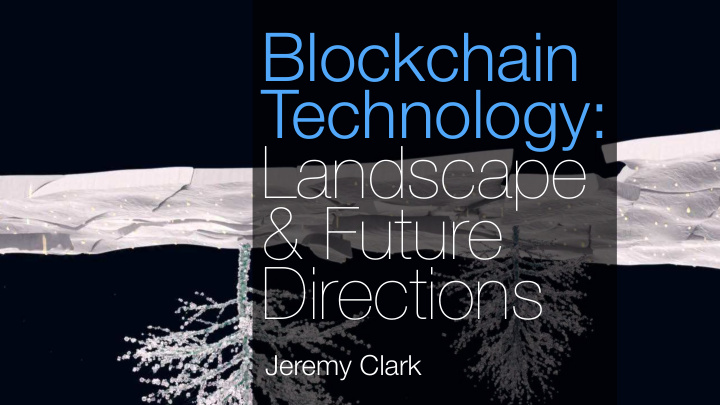



Blockchain Technology: Landscape & Future Directions Jeremy Clark
m A I e r e h W Jeremy Clark • Assistant Professor at the Concordia Institute for Information Systems Engineering (CIISE) in Montreal • PhD from the University of Waterloo (2009) • Team of eight graduate students • Numerous academic papers on Bitcoin/Blockchain, including one of the earliest • Contributed to courses (Princeton, MIT) & textbook on Bitcoin/blockchain • Testified to Senate and House committees on Bitcoin/blockchain
Digital Revolution Blockchain
Digital Revolution For business processes based on paper records, digitization increases efficiency
🚣
🚣
🚣
🚣
🚣
🚣
Digital Revolution
Digital Revolution Database
T-2351 T-4528 T-9636 T-9833
T-2351 T-4528 T-9636 T-9833 Who Owns the Database? Privileged Position Availability Manage Access
T-2351 T-4528 Reconciliation T-9636 T-9833 Who Owns the Database? Privileged Position Availability Manage Access
T-2351 T-4528 T-9636 T-9833
T-2351 T-4528 T-9636 T-9833 T-2351 T-4528 T-9636 T-9833 T-2351 T-2351 T-4528 T-4528 T-9636 T-9636 T-9833 T-9833
T-2351 T-4528 T-9636 T-9833 T-2351 Disintermediation T-4528 T-9636 T-9833 T-2351 T-2351 T-4528 T-4528 T-9636 T-9636 T-9833 T-9833
Blockchain T-2351 T-4528 T-9636 T-9833 T-2351 T-4528 T-9636 T-9833 T-2351 T-2351 T-4528 T-4528 T-9636 T-9636 T-9833 T-9833
Blockchain T-2351 T-4528 T-9636 T-9833 T-2351 T-4528 Data cannot be changed once written T-9636 Data is only written if it is true (truth by definition) T-9833 Everyone sees the same data; no reconciliation Data is readily available T-2351 T-2351 T-4528 T-4528 T-9636 T-9636 T-9833 T-9833
Blockchain T-2351 T-4528 T-9636 T-9833 T-2351 T-4528 Data cannot be changed once written T-9636 Data is only written if it is true (truth by definition) T-9833 Everyone sees the same data; no reconciliation Data is readily available Data can activate processes which are validated T-2351 T-2351 T-4528 T-4528 T-9636 T-9636 T-9833 T-9833
Use Cases • Securities: stocks, bonds, derivatives, swaps, repos and post-trade settlement • Markets: land deeds, carbon credits • Banking: inter-bank settlement, international payments, remittances, micropayments, loyalty • Provenance: luxury goods, organic certifications, supply chain management • Government: voting, registries • Coordination: internet of things • Identity management: KYC, PKI • Fun: gambling, prediction markets
Use Cases • Securities: stocks, bonds, derivatives, swaps, repos and post-trade settlement • Markets: land deeds, carbon credits • Banking: inter-bank settlement, international payments, remittances, micropayments, loyalty • Provenance: luxury goods, organic certifications, supply chain management • Government: voting, registries Blockchain systems can interact • Coordination: internet of things • Identity management: KYC, PKI • Fun: gambling, prediction markets
Frequently Asked Questions & common misconceptions
Relation to Bitcoin Bitcoin is designed to be a currency (BTC) Bitcoin is not a digital form of an existing currency Thus not like Paypal, EFTs, interact-by-email Bitcoin is decentralized: no central bank
The term blockchain 1) Bitcoin’s protocol for achieving a distributed ledger maintained by an open network of profit- seeking nodes 2) Any distributed ledger 3) The philosophy behind Bitcoin: digitizing commodities, securities, deeds, contracts…
Blockchain v. Database • Blockchains and (distributed) databases are similar and somewhat interchangeable • The emphasis is on different things • Blockchains are for small data (1MB every 10 min) • Blockchains are for validated data • Blockchains are not about complex queries (you download everything) • Blockchains are secure against malicious nodes
Standards • CAC-ISO-TC307: Blockchain and electronic distributed ledger technologies • Industry Consortiums: Various Regulation • Use-Case Specific: Mostly pertains to Bitcoin • Taxation: capital gain • Accounting (IFRS): intangible asset • KYC/AML: Fintrac given authority • ICOs/Trusts/Exchanges: Securities authorities
Confidentiality & Privacy • By default, blockchains have no confidential transactions • Confidentiality can be added on with encryption but non-trivial • By default, blockchains have no identities associated to transactions • Identities can be added (or conversely, anonymity strengthened)
Proof of Work Consistency? Consensus through voting
Honest majority Consistency? Consensus through voting
Honest majority Consistency? Consensus through voting One vote per ________?
Honest majority Consistency? Consensus through voting One vote per ________? 1) Entity: trusted list of entities, closed network
Honest majority Consistency? Consensus through voting One vote per ________? 1) Entity: trusted list of entities, closed network 2) Unit of computational effort: Bitcoin’s blockchain No trust, open network
ACM Queue
linked Byzantine public timestamping, digital proof fault keys as smart verifiable logs cash of work tolerance identities contracts 1980 Merkle Chaum Ecash [10] Tree [33] Byzantine anonymous Generals [27] communication [9] Chaum security w/o 1985 identification [11] offline Paxos [28] Haber & Ecash [32] Stornetta [22] DigiCash 1990 Benaloh & de Mare [6] anti-spam [15] Bayer, Haber, Szabo Stornetta [5] essay [41] 1995 Micro- mint [44] Haber & b-money [13] hashcash [2] Stornetta [23] client PBFT [8] Goldberg puzzles disser- Paxos made 2000 tation [20] [25] simple [29] Sybil attack [14] Bit gold [42] 2005 computational Bitcoin [34] impostors [1] private 2010 blockchains Ethereum 2015 Nakamoto concensus
More resources
Bitcoin and Cryptocurrency Technologies Arvind Narayanan, Joseph Bonneau, Edward Felten, Andrew Miller, Steven Goldfeder with a preface by Jeremy Clark Draft — Feb 9, 2016 Feedback welcome! Email bitcoinbook@lists.cs.princeton.edu For the latest draft and supplementary materials including programming assignments, see our Coursera course . The official version of this book will be published by Princeton University Press in 2016. If you’d like to be notified when it’s available, please sign up here .
ACM Queue
Q @PulpSpy
Recommend
More recommend